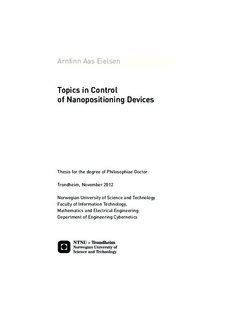| dc.description.abstract | Nanopositioning concerns motion control with resolution down to atomic scale. Positioning devices with such a capability have applications in numerous areas in industry and science. Examples include scanning probe microscopy, adaptive optics, hard disk drive systems, and the production and inspection of high-density semiconductor designs. Scanning probe microscopy is perhaps the most prominent example, as it is a versatile tool, which can be used for imaging, metrology, and physical manipulation. In imaging applications, the achievable resolution, or accuracy, is the most important performance criterion. For metrology and manipulation, trueness is also of importance. Additionally, the maximum achievable throughput, or bandwidth, of nanopositioning systems is an important performance criterion, as it lays the foundation for fast measuring and manipulation of physical properties; capturing processes at the time scale which they occur, reducing time and cost related to metrology, and enabling fabrication of nanoscale features at an industrial scale.
Nanopostitioning devices ubiquitously use piezoelectric actuators, as such actuators enable fast and frictionless motion. Piezoelectric actuators are as such ideal for high resolution positioning tasks. Positioning devices utilizing piezoelectric actuators typically exhibit lightly damped vibration modes, as well as hysteresis and creep non-linearities. Lightly damped vibration modes limits the achievable bandwidth, and hysteresis and creep limits the trueness of such devices. In order to improve bandwidth and trueness, these phenomena can be countered using feedforward and feedback control.
Part I of this thesis presents an adaptive feed-forward technique to compensate for the hysteresis non-linearity. It is based on the Coleman-Hodgdon model, and provides an open-loop observer for the hysteretic behavior which can be used to linearize the output of an actuator which exhibit hysteresis that can be modeled with said model. The model provides a good description of hysteresis responses that are symmetric, and the compensation method provides the best performance for stationary periodic reference trajectory signals. It is also pointed out that hysteresis can be interpreted as an uncertain gain and an input disturbance, and as such, regular feedback control using high quality position sensors can also effectively reduce the effect of hysteresis if the bandwidth is sufficiently high, and if the control law is robust towards variation in low-frequency gain. The drawback is increased position noise, due to sensor noise being amplified and fed back into to the actuation signal.
Part II concerns so-called damping and tracking control, and presents several low-order control schemes to improve bandwidth by damping lightly damped vibration modes, and by doing so, allowing for higher gain in the feedback control law. A practical tuning procedure is introduced in order to find optimal control law parameters, using an flatness criterion for the complementary sensitivity function. The effect of quantization noise due to implementation on digital signal processing equipment is investigated, and a particular simple damping and tracking control law is introduced, which consists of an integrator and a low-pass filter. The lowpass filter can be implemented using the anti-aliasing and reconstruction filters needed when using digital signal processing equipment, and only the integrator needs to be implemented digitally. The optimal tuning of this control structure turns out to limit the bandwidth of the anti-aliasing and reconstruction filters, and due to the limited bandwidth of the reconstruction filter, quantization noise is effectively attenuated. This control scheme is then coupled with a repetitive control scheme, which provides good tracking of periodic reference signals. A simple time-delay with positive feedback is a model for any periodic signal with a fixed period, and the repetitive control scheme includes this model in the feedback path, and can thus null any exogenous periodic signal with that fixed period to the error signal, due to the internal model principle. A criterion for robust stability of the damping and tracking control law combined with the repetitive control scheme is presented, which ensures stability for a prescribed unstructured uncertainty incorporating variable gain due to, among other factors, hysteresis, and high-frequency non-modeled dynamics.
Part III discusses adaptive control for arbitrary reference trajectory signals. Instrumentation used in nanopositioning systems typically allow for output feedback only, and the application of the standard framework for output feedback for dominantly linear systems, the model reference adaptive control scheme, is investigated. The model reference adaptive control scheme requires the usage of an online adaptive law in order to learn the parameter values of an uncertain model, and two common parameter identification schemes, the recursive least-squares method and the extended Kalman filter, are assessed for their ability to learn the parameters of a mass-spring-damper system using experimental data recorded using a nanopositioning device with two different payload configurations in open-loop. The result is a special pre-filter, which is demonstrated to improve parameter convergence. The model reference adaptive control scheme is then assessed experimentally, and it is demonstrated that a further refinement of the pre-filter is needed in order to obtain reasonable parameter convergence in closed-loop. An integral adaptive law is used in this case, in order to improve the convergence rate of the parameter estimates.
The main contributions of the thesis are methods for feed-forward and feedback control that can achieve similar or better performance than existing methods, but with lower complexity, which improves practical implementability. | nb_NO |
